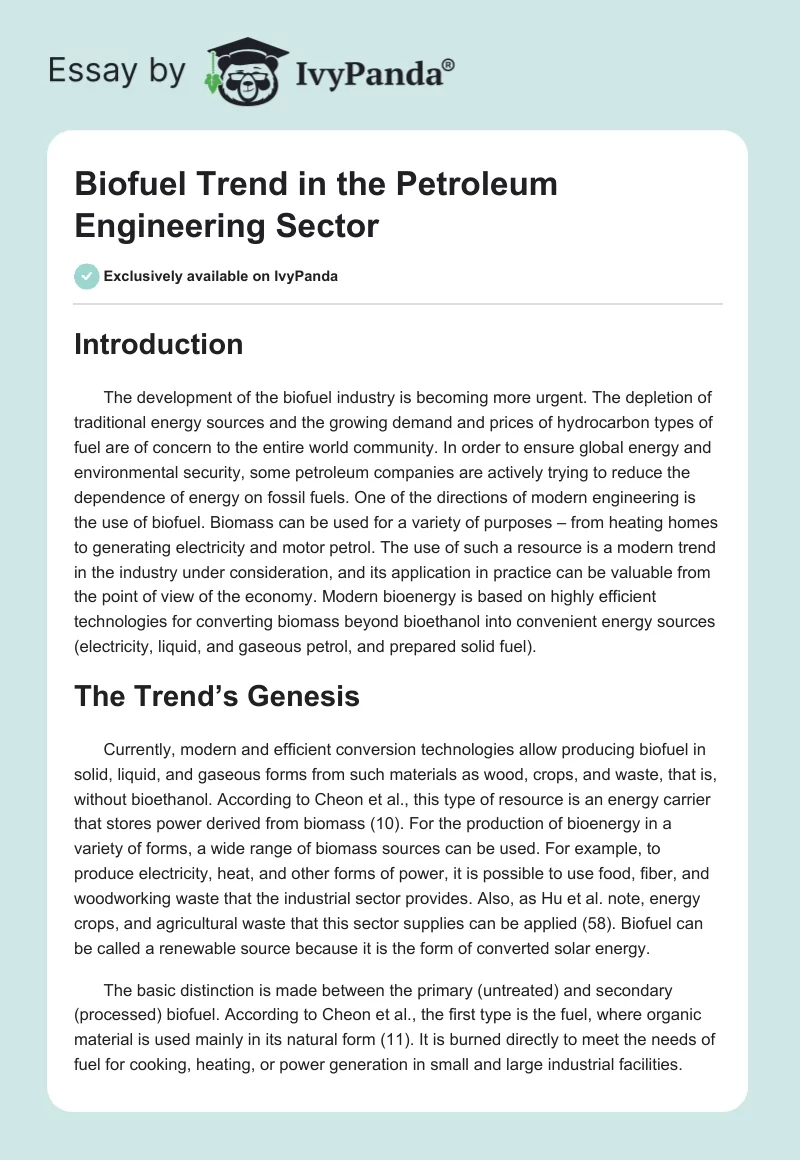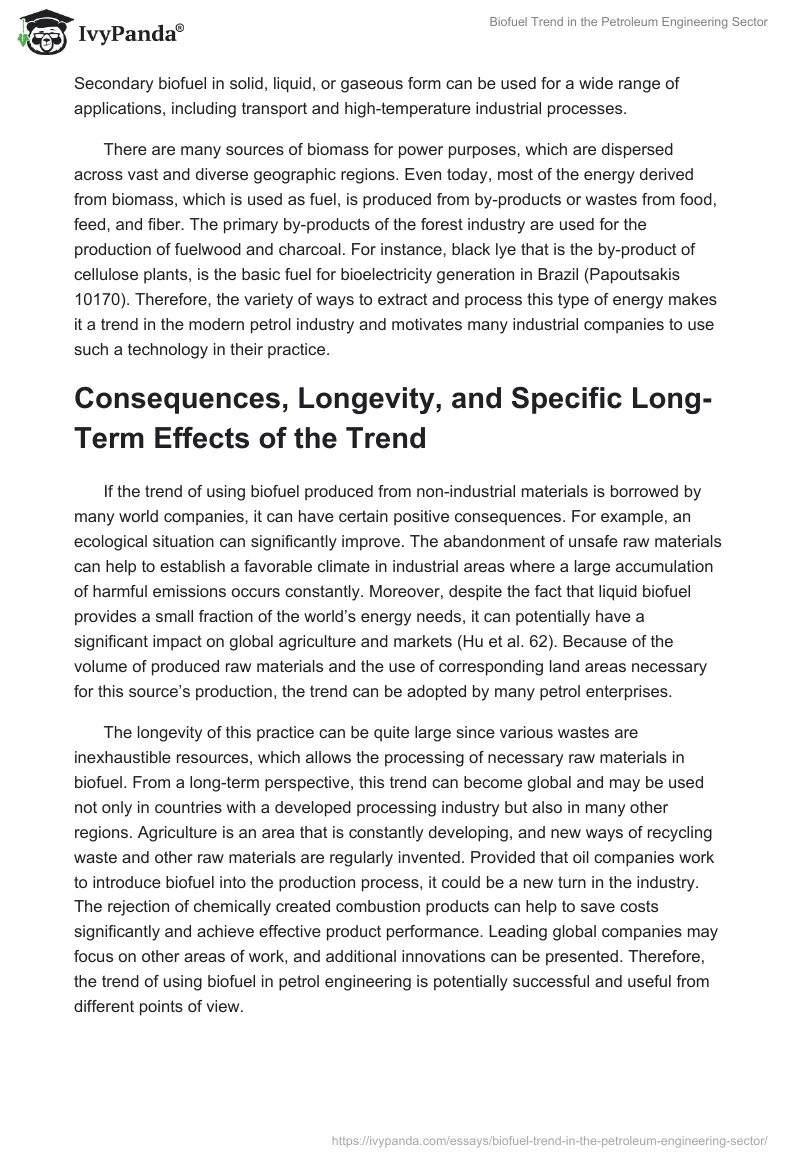Introduction
The development of the biofuel industry is becoming more urgent. The depletion of traditional energy sources and the growing demand and prices of hydrocarbon types of fuel are of concern to the entire world community. In order to ensure global energy and environmental security, some petroleum companies are actively trying to reduce the dependence of energy on fossil fuels. One of the directions of modern engineering is the use of biofuel. Biomass can be used for a variety of purposes – from heating homes to generating electricity and motor petrol. The use of such a resource is a modern trend in the industry under consideration, and its application in practice can be valuable from the point of view of the economy. Modern bioenergy is based on highly efficient technologies for converting biomass beyond bioethanol into convenient energy sources (electricity, liquid, and gaseous petrol, and prepared solid fuel).
The Trend’s Genesis
Currently, modern and efficient conversion technologies allow producing biofuel in solid, liquid, and gaseous forms from such materials as wood, crops, and waste, that is, without bioethanol. According to Cheon et al., this type of resource is an energy carrier that stores power derived from biomass (10). For the production of bioenergy in a variety of forms, a wide range of biomass sources can be used. For example, to produce electricity, heat, and other forms of power, it is possible to use food, fiber, and woodworking waste that the industrial sector provides. Also, as Hu et al. note, energy crops, and agricultural waste that this sector supplies can be applied (58). Biofuel can be called a renewable source because it is the form of converted solar energy.
The basic distinction is made between the primary (untreated) and secondary (processed) biofuel. According to Cheon et al., the first type is the fuel, where organic material is used mainly in its natural form (11). It is burned directly to meet the needs of fuel for cooking, heating, or power generation in small and large industrial facilities. Secondary biofuel in solid, liquid, or gaseous form can be used for a wide range of applications, including transport and high-temperature industrial processes.
There are many sources of biomass for power purposes, which are dispersed across vast and diverse geographic regions. Even today, most of the energy derived from biomass, which is used as fuel, is produced from by-products or wastes from food, feed, and fiber. The primary by-products of the forest industry are used for the production of fuelwood and charcoal. For instance, black lye that is the by-product of cellulose plants, is the basic fuel for bioelectricity generation in Brazil (Papoutsakis 10170). Therefore, the variety of ways to extract and process this type of energy makes it a trend in the modern petrol industry and motivates many industrial companies to use such a technology in their practice.
Consequences, Longevity, and Specific Long-Term Effects of the Trend
If the trend of using biofuel produced from non-industrial materials is borrowed by many world companies, it can have certain positive consequences. For example, an ecological situation can significantly improve. The abandonment of unsafe raw materials can help to establish a favorable climate in industrial areas where a large accumulation of harmful emissions occurs constantly. Moreover, despite the fact that liquid biofuel provides a small fraction of the world’s energy needs, it can potentially have a significant impact on global agriculture and markets (Hu et al. 62). Because of the volume of produced raw materials and the use of corresponding land areas necessary for this source’s production, the trend can be adopted by many petrol enterprises.
The longevity of this practice can be quite large since various wastes are inexhaustible resources, which allows the processing of necessary raw materials in biofuel. From a long-term perspective, this trend can become global and may be used not only in countries with a developed processing industry but also in many other regions. Agriculture is an area that is constantly developing, and new ways of recycling waste and other raw materials are regularly invented. Provided that oil companies work to introduce biofuel into the production process, it could be a new turn in the industry. The rejection of chemically created combustion products can help to save costs significantly and achieve effective product performance. Leading global companies may focus on other areas of work, and additional innovations can be presented. Therefore, the trend of using biofuel in petrol engineering is potentially successful and useful from different points of view.
Conclusion
A highly efficient energy resource in the form of biofuel produced on the basis of non-chemical materials’ processing can be used to provide energy for different industries. The prospects of this practice allow industrial companies to avoid significant losses and to use natural components for fuel production. A positive impact is on the environment due to a reduction in the number of harmful emissions. In the future, this method can become a common working strategy of oil engineering and help companies to improve their efficiency while reducing costs.
Works Cited
Cheon, Seungwoo, et al. “Recent Trends in Metabolic Engineering of Microorganisms for the Production of Advanced Biofuels.” Current Opinion in Chemical Biology, vol. 35, 2016, pp. 10-21.
Hu, Wenhao, et al. “Comparative Techno-Economic Analysis of Advanced Biofuels, Biochemicals, and Hydrocarbon Chemicals via the Fast Pyrolysis Platform.” Biofuels, vol. 7, no. 1, 2016, pp. 57-67.
Papoutsakis, Eleftherios T. “Reassessing the Progress in the Production of Advanced Biofuels in the Current Competitive Environment and Beyond: What Are the Successes and Where Progress Eludes Us and Why.” Industrial & Engineering Chemistry Research, vol. 54, no. 42, 2015, pp. 10170-10182.


